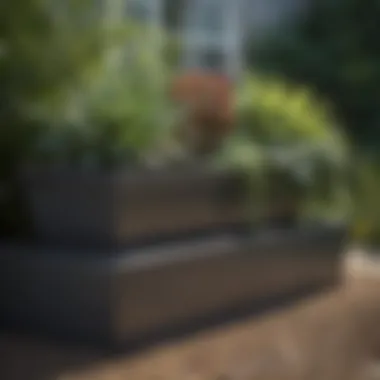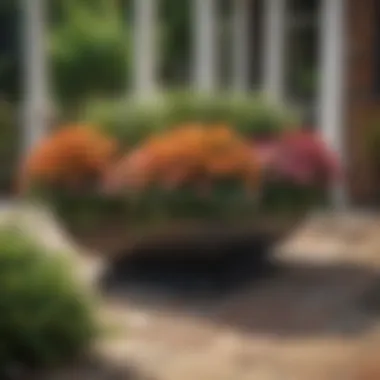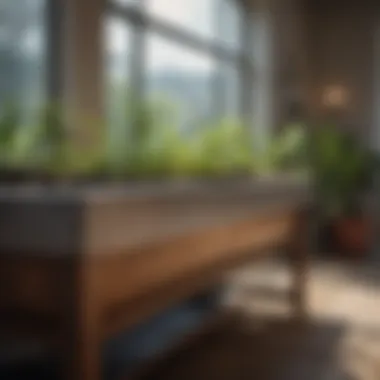The Aesthetic and Practical Benefits of Large Plant Troughs


Intro
Large plant troughs serve as versatile components in both residential and commercial spaces, enhancing the overall aesthetic appeal while providing functional benefits. As urban environments increasingly embrace greenery, understanding how these troughs can transform a space becomes essential for homeowners, interior design enthusiasts, and gardening aficionados alike. This article delves into the various aspects of large plant troughs, from design inspiration to essential gardening advice, ensuring a comprehensive understanding of their utility and beauty.
Design Inspiration
Trending Styles and Themes
When it comes to large plant troughs, the design possibilities are vast. Homeowners can choose from various styles that suit their personal taste and existing decor. For instance, contemporary designs often favor minimalist aesthetics, using simple lines and neutral materials like concrete or fiberglass. In contrast, rustic themes may incorporate wooden troughs or those made from natural stone, offering an earthy touch to outdoor or indoor spaces.
Some trending themes include:
- Modern Industrial: Featuring metals and sleek finishes, this style works well in urban settings.
- Botanical Sanctuary: Create a lush environment by using large troughs as focal points in gardens, filled with vibrant greenery and colorful flowers.
- Coastal Inspiration: Light woods and sea tones convey a relaxed vibe, perfect for beachside homes or patios.
Color Palettes and Combinations
The color of the trough itself, combined with the plants chosen, plays a significant role in achieving the desired visual impact. Neutral colors like grey and beige serve as versatile backdrops, allowing the lush colors of nature to take center stage. Alternatively, bold colors can create striking contrasts, especially when paired with vivid plants.
Consider these combinations:
- Subtle Greens with Dark Troughs: Allows the plants to pop.
- Pastel Flowers with Light-Colored Troughs: This combination promotes a soft, inviting atmosphere.
- Monochrome Schemes: Black troughs with white flowers create a modern, sophisticated look.
"The thoughtful selection of colors not only elevates the aesthetic appeal but also creates a harmonious connection between the troughs and plants."
Gardening Advice
Seasonal Planting Guides
Choosing the right plants for large troughs involves understanding the seasonal changes. Different plants thrive in different conditions. Spring is ideal for planting annuals such as petunias and marigolds, while summer may see the introduction of heat-tolerant varieties like succulents and ornamental grasses. In fall, consider adding hardy perennials that can withstand colder temperatures.
A basic seasonal guide includes:
- Spring: Petunias, Marigolds, and Snapdragons
- Summer: Succulents, Ornamental Grasses, and Lavender
- Fall: Asters, Mums, and Ornamental Kale
- Winter: Evergreens and Twigs from deciduous plants for visual interest
Maintenance and Care Tips
Maintenance is crucial for ensuring that large plant troughs remain functional and visually appealing. Regular watering, especially in warmer months, is essential. Most plants in troughs require consistent moisture, so check them frequently. Additionally, fertilizing around mid-summer can help boost plant growth, providing nutrients needed for flourishing foliage.
Some essential maintenance tips include:
- Monitor drainage: Ensure proper drainage to avoid waterlogging.
- Trim regularly: Cut back dead or overgrown plants to promote healthy growth.
- Clean troughs: Remove debris to prevent pests and diseases.
Integrating large plant troughs into your space not only enhances beauty but also fosters a deeper connection with nature. Understanding various design options and maintaining these gardening elements can significantly improve the attractiveness and functionality of your living spaces.
Prolusion to Large Plant Troughs
Large plant troughs have gained significant prominence in both residential and commercial spaces. Their unique ability to combine functionality with aesthetic appeal makes them more than mere containers for plants. They serve as focal points in gardens, patios, and indoors, effectively enhancing overall design while optimizing available space. Understanding the utility and aesthetics of these troughs leads to informed choices that benefit homeowners and design enthusiasts alike.
Definition and Overview
Large plant troughs are elongated containers primarily used for planting greenery. These troughs can range in size, accommodating a variety of plants, from herbs to larger shrubs. Made from different materials, such as wood, metal, and composite, their design allows for diverse planting options, leading to appealing landscape arrangements. The versatility of large plant troughs is a major advantage, as they can be adapted to various environmental conditions and styles.
Historical Significance
The usage of large plant troughs dates back to ancient civilizations, where they functioned as essential components in gardens. Initially constructed of clay or stone, they were used to cultivate herbs or flowers and were often found in courtyards and public spaces. Over time, large plant troughs evolved, reflecting changes in gardening practices and aesthetic preferences. In various cultures, they held symbolic significance, representing growth, abundance, and beauty. Understanding this historical context enriches our appreciation for large plant troughs today, as they bridge past and present gardening philosophies.
Design and Aesthetic Appeal
The design and aesthetic appeal of large plant troughs hold significant importance in this article. They serve not only as functional elements in various spaces but also as a vital part of the decor. A well-designed trough can enhance the beauty of both indoor and outdoor environments. This section explores various elements, benefits, and considerations in creating visually appealing large plant troughs.
Material Choices for Troughs
Each material has unique characteristics that can influence the overall look and feel of a trough.


Wooden Troughs
Wooden troughs are renowned for their warmth and organic appearance. The natural textures and colors of wood can complement many design styles. One of their key characteristics is their versatility; they can easily blend into garden settings or modern interiors. A prevalent choice, wooden troughs usually come in reclaimed or sustainable options, ensuring an eco-friendly alternative.
However, there are some disadvantages to consider. Wood requires regular maintenance to prevent rot and damage from pests. Additionally, depending on the type of wood used, inclination to warp or shrink could pose issues.
Metal Troughs
Metal troughs contribute a robust, industrial feel to any design. Their sleek surfaces can support a modern aesthetic. A key characteristic of metal troughs is durability; they can withstand various weather conditions without deteriorating. This makes them suitable for both indoor and outdoor use.
Nevertheless, metal can heat up quickly under sunlight, which may affect plant health. Moreover, methods of rust prevention must be considered to extend the lifespan of metal troughs.
Concrete Troughs
Concrete troughs are celebrated for their strength and permanence. They provide a substantial presence in any landscape or room. The key characteristic of concrete is its ability to sculpt into various shapes, allowing for creative designs. Concrete troughs are generally resistant to the elements and do not require extensive maintenance.
On the downside, they can be heavy and challenging to move, which limits flexibility in arranging spaces. Moreover, the texture generally is less inviting than other materials.
Composite Materials
Composite materials combine various elements to create an appealing and functional trough. They typically mimic the look of wood or stone while offering extra durability. The main characteristic of composite materials is their resistance to fading and degradation. This makes them a popular, sustainable option for many.
However, they may lack some aesthetic appeal compared to natural materials. Some may find composite materials a bit too synthetic, which may not appeal to those looking for authenticity in their design.
Finishes and Styles
Furthermore, the finish and style of plant troughs play a critical role in their aesthetic impact.
Rustic Designs
Rustic designs evoke a sense of simplicity and natural beauty. They often include imperfections and a rough finish that give them charm. The key characteristic of rustic designs is their ability to blend seamlessly with natural surroundings. These designs are popular because they create warmth and invite a casual atmosphere.
However, rustic troughs may not fit well in more modern or minimalist environments, possibly clashing with other design elements.
Modern Minimalism
Modern minimalist designs focus on simplicity, clean lines, and uncluttered spaces. The key characteristic of these troughs is their understated elegance. With limited color palettes and sharp shapes, these designs appeal to those who favor a contemporary style. This makes them a beneficial choice for urban settings and sophisticated interiors.
However, some may argue that the lack of ornamentation could render the troughs less engaging.
Industrial Aesthetic
An industrial aesthetic is rooted in functionality and raw materials. Troughs designed in this style often showcase metal, concrete, and exposed wood. This unique feature contributes a bold statement to any space. The key characteristic of industrial aesthetics is their focus on utilitarian beauty. They are beneficial for adding character and can work in both creative and corporate settings.
One downside is that this aesthetic can be too harsh or cold for some, which may detract from a cozy or inviting atmosphere.
Functional Advantages
Understanding the functional advantages of large plant troughs is essential, as it directly reflects their utility in various settings, whether residential or commercial. These multi-faceted containers not only enhance the aesthetic appeal but also offer significant benefits that can improve space utilization and provide versatility. As homeowners and designers look for ways to optimize their environments, recognizing these advantages fosters smarter decision-making in choosing the right planting solutions.
Space Optimization
Space optimization is a fundamental advantage of large plant troughs. They allow for effective use of limited areas, transforming nooks or corners into vibrant green spaces. Compared to traditional garden beds, troughs can fit into smaller or more unusual spaces, such as balconies or courtyards, without overwhelming them. By adding height and structure, they can also serve as visual dividers in larger areas. Moreover, placing plants vertically in troughs can free up ground space for other uses, like seating or pathways.
Versatility in Usage
Large plant troughs boast remarkable versatility, making them suitable for a variety of applications across different settings.
Indoor Applications
Indoor applications of large plant troughs highlight their adaptability to interior design. They serve as natural air purifiers, improving indoor air quality while enhancing the overall aesthetic of a room or space. The key characteristic of indoor troughs is their ability to contain soil and moisture while allowing for unique planting arrangements. This feature makes them excellent for creating focal points or adding life to otherwise dull spaces. However, they require consistent care to manage watering and light conditions, which can be a challenge in certain indoor environments.
Outdoor Applications
Conversely, outdoor applications of large plant troughs are extensive. They act as decorative elements on patios, gardens, or public spaces, transforming outdoor areas into inviting environments. Their durability and weather resistance are key characteristics that set them apart. Large outdoor troughs can accommodate diverse plant types and seasonal variations. However, exposure to outdoor elements necessitates careful selection of materials to withstand weather conditions, which can sometimes limit choices.


Commercial Use
For commercial use, large plant troughs can significantly impact business environments. They enhance outdoor spaces in restaurants, hotels, or office buildings, offering an appealing first impression to visitors. The ability to customize these troughs with different plants or layouts helps create unique branding opportunities. Their presence can foster a sense of well-being among employees and customers. However, the ongoing maintenance needed can be a downside for businesses with limited resources.
In essence, large plant troughs are not just aesthetic choices; they serve significant functional purposes that can enhance the way spaces are experienced.
Planting Options for Large Troughs
Choosing the right plants for large troughs is essential for creating a vibrant and thriving garden space. The selection of plants greatly influences visual appeal as well as plant health and maintenance needs. Different plants have varying requirements in terms of light, water, and space. Therefore, understanding the types of plants suitable for troughs can optimize their utility and aesthetics. This section covers various categories of plants that work well in large troughs, highlighting their unique characteristics, benefits, and considerations.
Selecting the Right Plants
Perennials vs. Annuals
Perennials and annuals are two main categories of plants prominent in gardening. Perennials are plants that persist for multiple growing seasons. They return year after year, often leading to lower costs in the long term because there is no need to replant them each season. These plants can create a sense of permanence in your garden. However, they may take longer to establish and bloom compared to annuals. Annuals, on the other hand, complete their life cycle in one growing season, which means they bloom quickly and can provide vibrant colors instantly. This difference makes annuals ideal for seasonal changes and short-term displays.
In the context of large troughs, a mix can yield a full, lush appearance that blooms throughout the growing season, thus benefiting both aesthetics and maintenance effort.
Herbs and Vegetables
Incorporating herbs and vegetables into large troughs is a practical choice that enhances utility. Growing edible plants allows gardeners to enjoy fresh flavors right from their balcony or backyard. Key characteristics of herbs include their aromatic properties and diverse uses in cooking. Vegetables, depending on the type, can offer nutrition and also contribute to the aesthetic appeal with their varying textures and colors.
One consideration is the growth habits of these plants. Some may require more space or different watering needs. It's crucial to choose varieties that suit the size of the trough and each others' compatibility to maximize yield and minimize competition.
Succulents and Cacti
Succulents and cacti represent a unique choice for large troughs, especially in drier climates. These plants are known for their ability to store water in their leaves, stems, or roots, allowing them to thrive in less water. Their diverse forms and colors make them visually striking, and they generally require less maintenance than many other types of plants.
However, succulents and cacti do often require well-draining soil and full sunlight, which can be a limitation in shaded areas. Additionally, their occasional blooms some can be brief but spectacular, adding interest to the trough. Understanding the environmental conditions of your planting space is crucial to fully enjoy the advantages of these plants.
Creating Plant Combinations
Building effective plant combinations can take your garden design to a higher level. Thoughtful plant combinations consider aesthetics, growth patterns, and seasonal changes, creating harmony in the overall space.
Color Theory in Plantings
Applying color theory to plantings can significantly enhance the visual appeal of large troughs. Different colors provoke various emotional responses and can draw focus to specific areas of your arrangement. By understanding the color wheel, you can create combinations that work cohesively together.
For instance, complementary colors can create a vibrant and dynamic look. On the other hand, analogous colors produce a soothing and harmonious design. Strategically choosing plants based on their flower or foliage color can also set the mood of your space, making it feel more inviting or energetic.
Height Variation
Height variation among plants is another important aspect. Incorporating a mix of tall, medium, and short species increases depth in the design and prevents monotony. Tall plants can serve as a backdrop, while shorter ones can fill the space in front. This layering achieves a more visually interesting trough.
Moreover, varying heights can protect smaller plants from harsh elements and offer shade to those that prefer cooler conditions. Creating an engaging vertical arrangement not only improves aesthetics but also maximizes the use of space.
Seasonal Planting Schemes
Implementing seasonal planting schemes can enhance the functionality of large troughs as well. Choosing a mix of plants that bloom at different times allows for color and interest throughout the year. When plants die back in the fall or winter, others can bring visual appeal to the arrangement. This strategy allows you to maintain a thriving garden that changes with the seasons, providing a new experience for the viewer as well as benefits to local wildlife.
Maintenance and Care
A plant trough serves not just as an aesthetic component in landscaping but also requires consistent maintenance and care to ensure longevity and flourishing plants. Proper upkeep enhances the functionality and visual appeal of large plant troughs. This section explores the vital aspects of maintaining these functional designs in gardens, patios, and homes.
Watering Requirements
Watering is crucial for the health of the plants in your trough. It ensures that they receive adequate moisture, which supports growth and vitality. Understanding the specific needs of different plant species helps determine the watering frequency. Some plants prefer drier soil, while others thrive in consistently moist environments.
Using self-watering mechanisms or irrigation systems can simplify this task. Regular checks for moisture levels in the soil is important. Feel the soil a couple of inches down to assess dampness. Over-watering or under-watering can lead to problems such as root rot or nutrient deficiency.
Soil Management
Soil is the foundation for healthy plants. Managing soil in large troughs involves two key elements: composition and drainage.


Soil Composition and Drainage
Soil composition is important in determining how well plants grow. A good mix of organic matter, such as compost, with mineral components supports plant health. This blend facilitates proper drainage, ensuring roots do not sit in water, which can be harmful.
One beneficial aspect of proper drainage is preventing the buildup of excess water, which can lead to rot and other diseases. Additionally, well draining soil encourages root growth and absorbs nutrients effectively, further boosting plant health.
Fertilization Practices
Fertilization is essential to replenish soil nutrients, especially in contained spaces like plant troughs. Regularly adding fertilizers can provide the plants with essential minerals and nutrients.
Choosing organic fertilizers tends to be a popular practice due to their gradual release of nutrients. However, synthetic options can produce quicker results for fast-growing plants. It’s important to follow application guidelines to avoid nutrient burn. Understanding specific plant needs assists in effective fertilization, balancing between growth and sustainability.
Pest and Disease Control
Pest management is essential for maintaining the health of plants in troughs. Recognizing issues early on is crucial.
Identifying Common Issues
Common pests like aphids or spider mites can infest plants, detracting from their health and appearance. Recognizing the symptoms of infestations—such as discolored leaves or webbing—can lead to swift treatment and prevent further damage.
Using integrated pest management approaches can minimize harm to the ecosystem. Simple strategies like introducing beneficial insects help control pest populations naturally.
Preventative Measures
Preventative measures can significantly reduce the presence of pests and diseases. Regularly inspecting plants for signs of issues is key. Encouraging biodiversity in plant selections and maintaining good cultural practices promote healthier environments, which makes plants less susceptible to pests.
Important: Use sterile soil and clean tools to prevent disease spread. Regular maintenance ensures longevity and success in gardening with large troughs.
Proper care of large plant troughs not only preserves their beauty but also enhances the overall health and growth of the plants within.
Innovative Trends in Plant Troughs
The realm of large plant troughs is ever-evolving, with innovative trends shaping how they are designed, utilized, and integrated into both residential and commercial spaces. These trends reflect a growing awareness of environmental responsibility and an increasing desire for smart gardening solutions. The following sections will delve into two key trends: eco-friendly designs and the integration of smart technologies.
Eco-Friendly Designs
Eco-friendly designs in large plant troughs emphasize sustainability and the use of materials that have less impact on the environment. With the pressing issues of climate change and urban heat islands, the demand for such designs is on the rise.
Utilizing recycled materials is one popular approach. Troughs made from reclaimed wood or upcycled plastics not only reduce waste but also add unique character to gardens. Additionally, certain materials, like corten steel, develop a protective layer over time, reducing the need for chemical treatments.
Incorporating native plants in eco-friendly designs promotes biodiversity. These plants require less water and maintain local ecosystems. Such choices not only enhance aesthetics but also foster stronger connections between the garden and its local environment. Using permeable surfaces for trough placement can also mitigate stormwater runoff, aligning with broader environmental goals.
Smart Technology Integration
Smart technology integration in plant troughs is revolutionizing gardening practices, providing convenience and efficiency. With innovations coming at a rapid pace, homeowners can easily maintain and cultivate their plant troughs with minimal effort.
Irrigation Systems
Automated irrigation systems stand out for their role in optimizing water consumption. These systems can be programmed to supply the right amount of water at the appropriate times, reducing waste. A key characteristic of these systems is their ability to assess weather conditions. When rain is forecasted, the system can adjust accordingly, preventing over-watering.
The benefit of this technology lies in its ease of use. For those who may lack time for regular watering, these systems ensure that plants receive the care they need without constant monitoring. However, installation costs can be a consideration for some, as initial investment might be higher than traditional methods.
Monitoring Plant Health
Monitoring plant health is another essential aspect of smart technology integration. This can include sensors that track soil moisture levels and nutrient content. A distinct feature of these systems is their real-time feedback. Gardeners can receive alerts directly on their phones regarding the needs of their plants, enabling immediate action when issues arise.
This technology serves as a powerful tool for ensuring optimal plant growth. It reduces the chance of under or over-caring for plants, which can often lead to diseases. On the downside, reliance on technology can be challenging for those who prefer a more hands-on approach to gardening. Despite this, the advantages often outweigh the disadvantages, appealing to modern gardening enthusiasts.
"The integration of technology in gardening moves us closer to a sustainable future while allowing for more informed and efficient choices in plant care."
End
The conclusion of this article serves as a critical reflection on the various aspects surrounding large plant troughs, emphasizing their role in enhancing both beauty and functionality in various settings. Plant troughs are not merely vessels for soil and plants; they symbolize a thoughtful design approach that integrates nature into both residential and commercial spaces. Understanding the concepts discussed throughout the article is essential for homeowners, interior design enthusiasts, and gardening aficionados looking to maximize the potential of their spaces.
Large plant troughs offer numerous benefits. Their versatility allows them to serve as focal points or simple enhancements to existing designs. By selecting the right materials and styles, users can ensure that these troughs complement the overall aesthetic of their environment. Additionally, appropriate plant selections enhance the visual appeal and can contribute to the ecosystem.
When considering the placement and maintenance of large plant troughs, it is essential to note the ongoing care they require. Understanding watering needs, soil management, and pest control are pivotal. Such details ensure an enduring investment—both financially and in terms of time.
Moreover, the innovative trends discussed reflect a growing commitment to sustainability and technology within this gardening sphere. Eco-friendly designs and smart technology integration pave the way for future developments, offering promising avenues for enhancing plant trough utility.
In summary, incorporating large plant troughs can significantly elevate aesthetics while providing functional benefits. Attention to design, choice of plants, and consistent care are crucial elements that collectively enhance the user experience. As this article illustrates, the path of integrating large plant troughs into various spaces embodies both art and science, resulting in a harmonious blend of nature and design that can elevate any environment.



